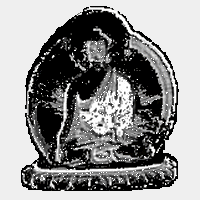

Pada I
Contemplation and Meditation
Pada II
The Steps To Union
Pada III
Union Achieved And Its Results
Pada IV
Illumination and Freedom
Yoga Sutras

of Patanjali
This is by far the best book on the subject. The sutras are beautifully explained in layman terms with ample annotations.
Click here for The Reluctant Messenger (Host Site)
Yoga Sutras of Patanjali
Translation by Chester Messenger

Introduction
The greatest classical text from the yoga school of Indian philosophy is the Yoga Sutras by Patanjali, written in the second century BC. These "threads" on yoga or union, are extremely terse, stating concisely and often precisely, essential points or techniques. Originally these teachings were oral and were explained and interpreted by commentaries from a teacher guiding the student.
This meditative discipline of liberation is called raja or royal yoga or the yoga of the eight steps, which may be listed as follows:
1. Restraint: nonviolence, not lying, not stealing, not lusting, and nonattachment 2. Observances: cleanliness, contentment, discipline, self-study, and surrender to the Supreme God 3. Posture or physical exercises 4. Breath control 5. Sublimation or withdrawal from the senses 6. Attention 7. Concentration 8. Meditation
Meaning and Purpose of the Yoga Sutras
Yoga means Union and the purpose is to teach the practitioner of Yoga, called the Yogi, how to achieve Union or Spiritual Absorption into the Supreme Absolute or God. Yoga teachs us that our true self is the soul and that our self identity is an illusion to be overcome.
These sutras do not go into the specifics of meditation, such as how to sit, what postures are best, etc... because it was assumed this material would be taught by a teacher to a student and that certain basics would be part of the instruction. It is recommended that the reader become famailiar with basic meditation techniques and postures before practicing these precepts.Organization of the Yoga Sutras
These sutras are in four parts (padas).1. Samadhi Pada I: Contemplation and Meditation 2. Sadhana Pada II: The Steps To Union 3. Vibhuti Pada III: Union Achieved And Its Results 4. Kaivalya Pada IV: Illumination and Freedom Notes on this Translation of the Yoga Sutras
The Yoga Sutras of Patanjali were originally written in Sanskrit which is an Indo-European language. Sankrit is the oldest of the Indo-European languages still in active use. It is closely related to ancient Greek, Latin, Avestan and many other languages. It is the mother of Hindi/Urdu, Bengali, Gujarati, Punjabi, Marathi, Nepali, Simhal(Srilanka) and many other languages. Many Indian and Asian languages use a large number of Sanskrit words. Ancient texts of Hindus of various traditions, Buddhists, Jains and Sikhs are in Sanskrit or related languages (Pali/Prakrit/Hindi). The language of Zoroastrian Avesta is a dialect of the Vedic Sanskrit. The word Sanskrit itself mean 'perfected polished literature' and is a highly organised language with a complex grammer.
It is very difficult to translate Sanskrit to English with a word for word literal equality. Many translations attempt to bypass this difficulty in two ways. One is to not translate certain words but to leave them in their anglicized spelling, whereas the reader is expected to learn the definition of the word. Another way the translator will transcend the problem will be to add commentaries further explaining each sentence or phrase. Both systems can be cumbersome to the reader.
This translation does not attempt word for word equality, instead translates each sanskrit word compound to an equivalent English phrase or word pair. This prevents burdening the reader with unfamiliar words or cumbersome commentary.
Also certain words should be recognized as to their intent and meaning. In typical English translations of Yoga concepts, the word Consciousness is frequently used. This word is imprecise when used in the context that Patanjali taught. In this translation the word Awareness is used as it more precisely delivers the meaning Patanjali intended since Consciousness has a connotation of mind and awareness in modern English, whereas Awareness is a more basic, purer concept.
Other important terms used here is the word integration or words meditative integration. In the context of the Yoga Sutras, this word refers to concentration, meditation, and spiritual absorption, jointly together, and is a key concept most translations render as samyama.
The words seer, meditator and Yogi can be considered equivalent in this text. Attempts have been made to render the text gender neutral, where it was too awkward the pronoun he or his is used.
Intro | Pada I | Pada II | Pada III | Pada IV
Samoht Etsaman 
Book of Chester: Introduction Part One: History of Eternity Part Two: Understanding God Part Three: God Talking Part Four: Sutras of the Seven Wisdoms Part Five: Sutras of Devotion Part Six: Yoga Sutras of Patanjali Bonus: The Practice Appendix: Science of Immortality
Meditation Links

of Patanjali
This is by far the best book on the subject. The sutras are beautifully explained in layman terms with ample annotations.
$3.99 Kindle eBook

Buy from Amazon.com
The Essential Teachings of Herbert W. Armstrong

His Teachings Focused on The Incredible Human Potential. Did He Solve the Mystery of the Ages?
New Book about HWA's Teachings. Recommended!

